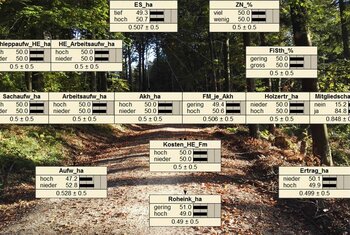Forest economics and management
Competing demands placed on the forest as a resource and the increase in risks mean that forest managers today face a broad spectrum of individual issues, making the use of many different methods essential for successful forest management. The new double name of the department reflects this.
In the forest business management field of work, it is primarily monetary issues that are dealt with. In addition to the continuation and further development of the business management databases (test operation networks), we also deal with classics such as forest valuation. But the comparatively new topic of restrictions on forest utilisation due to protection functions or the recreational services provided by the forest also plays an important role.
After almost two decades of dealing with risks and crises, these issues have been given new importance with the designation of an area of work focused on Risk and Crisis Management. The third thematic focus of the department is on sustainability management and decision support.
Areas of work
Forest business management
The Forest Economics and Management Department covers the entire spectrum of forest economics topics. When it comes to the more classic fields of business activity, the area of work focusing on “Forest Business Management” is where to look. These fields include traditional forestry cost and output accounting, controlling, forest valuation, organisational and strategic research, and the calculation of support programmes.
There is also an increasing focus on new types of cost structures. These include the economic impacts of nature conservation, recreation and other external influences on the forest, which cannot be represented using current business accounting systems.
As an essential data basis for economic calculations, the department operates two forestry monitoring networks. They guarantee a deep insight into the economic development of both private and public forest enterprises.
Contact
Reinhard Aichholz
Risk and crisis management
What if? This is the crucial question addressed by forestry risk and crisis management. While risk management focuses on identifying and controlling mostly undesirable deviations from operational goals, crisis management is dedicated to the systematic handling of crisis situations - both preventing them and reacting to them. There are many potential crises in forestry: Storms, calamities, climate change or even social upheaval.
This calls for information from all forestry disciplines, so that forest enterprises can adapt, both in the forest and in the enterprise as a whole. The transfer of knowledge from research to practice is of great importance for the successful integration of the sum of information into operational decisions. Which methods and cooperations are best suited to create awareness of the risks and challenges is the central research field of this area of work.
Contact
Dr. Yvonne Hengst
Sustainability management and decision support
Forests have always been more than just a production site for wood. They fulfil many other important services, such as noise protection, air pollution control, the reduction of air temperatures (particularly important in urban areas) as well as drinking water, soil and flood protection. Forests also provide important habitats for plants and animals, and contribute to the well-being, health and general feeling of satisfaction with life of the human population. However, the significance of the individual services provided by the forest was and is subject to permanent change, and is not free of conflicting goals. This area of work is about “keeping in mind” the demand for and provision of these diverse ecosystem services, and about developing methods to secure them in the long term. In other words, it is about ensuring sustainability in the forest in a comprehensive and dynamic sense. The scope of consideration ranges from a forest strategy at federal state level to decisions taken directly for the individual forest area within the framework of the forest management plan.
Given the diversity of interests in the forest, this requires procedures that make these different demands placed on the forest transparent, and that enable fair participation of the stakeholders. Where goals cannot be agreed upon, comprehensible methods are needed to support decisions on which priority is to be pursued in each individual case. This area of work focuses on the development and application of such methods, often in pilot projects.
Today, the often exemplary sustainable provision of these services in the forest compared to other forms of land use is no longer enough. Action in the forest must be explained, and both successes and identified needs for improvement must be credibly communicated and conveyed. Topics such as the communication behaviour of the forestry industry, modern didactic ways of imparting knowledge, but also new forms of reporting therefore play a role here. Examples of this are sustainability reports and common good balances.



